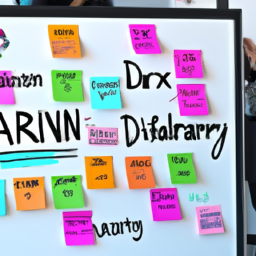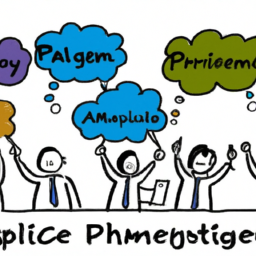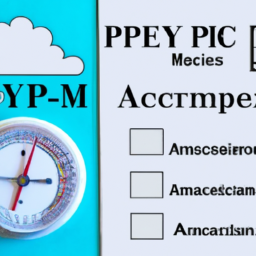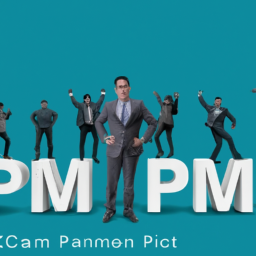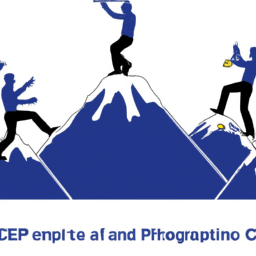Are you preparing for the PMI ACP exam? Well, you’re not alone. Over 25,000 professionals take this exam each year to enhance their Agile project management skills.
To succeed, you must master 11 essential exam topics. In this article, we will guide you through these topics, providing the necessary knowledge and insights to help you pass the exam with flying colors.
So, let’s dive right in and get you on the path to success!
Key Takeaways
- Agile principles promote iterative and incremental development, allowing for flexibility and adaptability throughout the project.
- Scrum framework emphasizes collaboration and iterative development, providing transparency and effective project management.
- Understanding Scrum roles and responsibilities contributes to team success in Agile project management.
- Agile principles align with Lean methodologies, aiming to minimize waste and maximize efficiency in project delivery.
Agile Principles and Values
Agile principles and values are essential for success in the PMI-ACP exam. Understanding the difference between agile principles and the traditional waterfall methodology is crucial.
Agile principles promote iterative and incremental development, allowing for flexibility and adaptability throughout the project. In contrast, the waterfall methodology follows a linear approach, with each phase depending on the completion of the previous one.
Adopting an agile mindset and culture is vital for embracing change and collaboration. It requires individuals and teams to prioritize customer satisfaction, continuous improvement, and delivering value early and often.
Scrum Framework
In the Scrum framework, you will encounter various roles and responsibilities that are crucial for the success of the project.
These roles include the Scrum Master, who facilitates the team’s progress, the Product Owner, who represents the stakeholders, and the Development Team, responsible for delivering the product.
Alongside these roles, Scrum also employs specific artifacts, such as the Product Backlog, Sprint Backlog, and Increment, which provide transparency and help in managing the project effectively.
To ensure smooth collaboration and progress, Scrum ceremonies like Sprint Planning, Daily Scrum, Sprint Review, and Sprint Retrospective are conducted at regular intervals.
Scrum Roles and Responsibilities
You should understand the roles and responsibilities in Scrum.
In Scrum team dynamics, there are three key roles: the Product Owner, the Scrum Master, and the Development Team.
The Product Owner is responsible for defining and prioritizing the product backlog, ensuring that the team is working on the most valuable features.
The Scrum Master is responsible for facilitating the Scrum process and removing any impediments that may arise.
The Development Team is responsible for delivering the product increment at the end of each sprint.
Agile project management is central to Scrum, as it emphasizes iterative and incremental development, continuous feedback, and collaboration among team members.
By understanding these roles and responsibilities, you can effectively contribute to the success of your Scrum team.
Now, let’s delve into the next section about Scrum artifacts and ceremonies.
Scrum Artifacts and Ceremonies
Let’s now explore the different artifacts and ceremonies in Scrum. Scrum is a framework that emphasizes collaboration, iterative development, and continuous improvement. It consists of various artifacts and ceremonies that help facilitate effective communication and ensure project success.
Here are three key aspects of Scrum that you should be familiar with:
-
Scrum Artifacts:
- Product Backlog: A prioritized list of user stories or requirements that need to be completed.
- Sprint Backlog: A subset of the Product Backlog that contains the tasks to be completed during a sprint.
- Increment: The sum of all completed Product Backlog items at the end of a sprint.
-
Scrum Ceremonies:
- Sprint Planning: A meeting where the team determines what can be achieved in the upcoming sprint.
- Daily Scrum: A brief daily meeting to discuss progress, plan for the day, and address any obstacles.
- Sprint Review: A meeting to review the increment and gather feedback from stakeholders.
Lean Software Development
In this discussion, you will explore the intersection of Agile principles and Lean software development. You will also learn about waste reduction techniques and continuous improvement strategies that are central to both methodologies.
By examining how Agile principles can be applied within a Lean framework, you will gain insights into how to maximize efficiency and minimize waste in your software development processes.
Additionally, you will learn how continuous improvement strategies can help you continually refine and optimize your development practices.
Agile Principles in Lean
Agile principles are deeply rooted in lean methodologies. By incorporating agile principles into lean practices, you can enhance the efficiency and effectiveness of your software development process.
Here are three key ways agile principles can be applied in a lean context:
-
Continuous Improvement: Agile promotes regular reflection and adaptation, allowing you to continuously improve your lean practices and deliver greater value to customers.
-
Empowered Teams: Agile emphasizes self-organizing and cross-functional teams, enabling them to make decisions and take ownership of their work within the lean framework.
-
Customer Collaboration: Agile encourages frequent customer feedback and collaboration, ensuring that lean practices are aligned with customer needs and delivering customer-centric solutions.
Waste Reduction Techniques
Now that you understand the importance of Agile principles in Lean, let’s delve into waste reduction techniques.
Waste is any activity or process that does not add value to the customer. Agile methodologies aim to minimize waste and maximize efficiency.
One of the waste reduction techniques commonly used in Agile is called ‘Kaizen.’ Kaizen encourages continuous improvement by eliminating waste incrementally.
Another technique is the ‘5S’ method, which focuses on organizing and standardizing the workspace to reduce unnecessary movement and improve productivity.
Additionally, Agile risk management plays a crucial role in waste reduction. By identifying potential risks early on and implementing mitigation strategies, Agile teams can minimize the impact of risks on project deliverables.
Continuous Improvement Strategies
To continuously improve, you should regularly review and analyze your processes and identify areas for optimization. Here are three continuous improvement strategies that can help you enhance your project management practices:
-
Adopt an Agile mindset: Embrace the principles of Agile and encourage your team to collaborate and adapt to change. Agile methodologies like Scrum and Kanban promote iterative development and continuous feedback, allowing for constant improvement.
-
Implement Lean techniques: Eliminate waste and streamline your processes by applying Lean principles. Identify and eliminate non-value-added activities, reduce cycle times, and optimize resource allocation.
-
Foster a culture of learning: Encourage your team to share knowledge and learn from each other’s experiences. Emphasize the importance of continuous learning and improvement, and provide opportunities for professional development.
Kanban Method
You should start implementing the Kanban Method in your project management practices.
Kanban is a popular agile framework that focuses on visualizing work, limiting work in progress, and improving overall workflow efficiency.
To begin kanban implementation, you’ll need a kanban board, which is a visual representation of your project’s workflow. The board typically consists of columns representing different stages of work, such as ‘To Do,’ ‘In Progress,’ and ‘Done.’ Each task is represented by a card that moves across the board as it progresses.
By using a kanban board, you and your team can easily see the status of each task, identify bottlenecks, and prioritize work effectively. This method promotes continuous improvement and enables a more efficient and streamlined project management process.
Start implementing kanban today to enhance your project management practices.
Agile Estimation and Planning
When it comes to Agile Estimation and Planning, there are two key points that you need to focus on: Story Point Estimation and Sprint Planning Techniques.
Story Point Estimation is a technique used to measure the effort and complexity of user stories.
Sprint Planning Techniques help teams determine what can be accomplished in a sprint and how to break down tasks.
Story Point Estimation
Understanding story point estimation is critical for mastering the PMI-ACP exam. As a project manager, you need to have a clear understanding of how to estimate the effort required to complete user stories in Agile projects. Story points are a popular method for estimating the relative size of user stories.
Here are three key concepts you should know about story point estimation:
-
Relative Sizing: Story points are assigned to user stories based on their complexity, effort, and risk. The relative sizing approach allows you to compare user stories and prioritize them accordingly.
-
Team Consensus: Story point estimation is a collaborative process that involves the entire Agile team. It is important to have open discussions and reach a consensus on the story point estimates to ensure accuracy and alignment.
-
Velocity: Velocity is a measure of the amount of work a team can complete in a given iteration. It is calculated by summing up the story points completed in each iteration. Velocity helps the team plan and forecast future iterations.
Sprint Planning Techniques
Now that you have learned about story point estimation, let’s dive into sprint planning techniques. Sprint planning is a crucial part of agile backlog management, as it sets the stage for a productive and successful sprint. During this process, the team collaboratively decides which user stories and tasks will be included in the upcoming sprint.
To effectively plan a sprint, it is important to consider the team’s capacity, prioritize the backlog items, and break them down into manageable tasks. This ensures that the team can deliver value within the sprint’s timeframe. Additionally, sprint planning involves defining the sprint goal and creating a sprint backlog.
To provide a visual representation of sprint planning techniques, here is a table that outlines key steps and considerations:
| Sprint Planning Techniques |
|---|
| Consider team capacity |
| Prioritize backlog items |
| Break down tasks |
| Define sprint goal |
| Create sprint backlog |
Agile Risk Management
Agile risk management is crucial for successfully implementing Agile methodologies. It involves identifying potential risks and taking necessary actions to mitigate them. Here are three key aspects of agile risk management that you should focus on:
-
Agile risk identification: This step involves actively seeking out potential risks that could impact the project. By identifying these risks early on, you can develop strategies to address them proactively.
-
Agile risk mitigation: Once risks are identified, it is important to take appropriate actions to minimize their impact. This could involve implementing contingency plans, adjusting project scope or timelines, or allocating additional resources.
-
Continuous monitoring: Agile risk management is an ongoing process. Regularly monitoring the project’s progress and reassessing risks will help you stay proactive and make necessary adjustments throughout the project lifecycle.
Continuous Integration and Continuous Delivery (CI/CD
To successfully implement CI/CD, you need to ensure that your development and deployment processes are seamlessly integrated. Continuous Integration (CI) and Continuous Delivery (CD) are essential practices in the DevOps world.
CI/CD aims to automate the software development lifecycle, enabling faster and more reliable delivery of software. Continuous integration tools play a crucial role in achieving this goal. These tools help in automating the build, test, and deployment processes, ensuring that any changes made to the code are immediately tested and integrated into the main codebase.
By adopting CI/CD and using the right continuous integration tools, you can reduce manual errors, increase collaboration between development and operations teams, and accelerate the release cycle.
Embracing DevOps practices and implementing CI/CD can lead to improved productivity, higher quality software, and increased customer satisfaction.
Agile Team Dynamics and Collaboration
By fostering effective collaboration and embracing agile team dynamics, software development teams can enhance productivity and deliver high-quality software. To achieve this, consider the following strategies:
-
Establish clear communication channels: Encourage open and transparent communication among team members. Use tools like instant messaging platforms or project management software to facilitate quick and efficient information sharing.
-
Encourage cross-functional collaboration: Break down silos and promote collaboration among different roles and departments. Encourage team members to share their expertise and work together towards a common goal.
-
Foster a culture of trust and psychological safety: Create an environment where team members feel comfortable sharing their ideas, asking for help, and taking risks. By fostering trust and psychological safety, team members can freely contribute and collaborate, leading to increased synergy and innovation.
Agile Product Quality and Testing
Implementing effective testing strategies and ensuring product quality are crucial components of successful software development projects. In agile product development, the focus is on delivering high-quality software in short iterations. Agile testing techniques play a vital role in achieving this goal.
By incorporating continuous testing throughout the development process, you can uncover defects early and address them promptly. Agile testing emphasizes collaboration and communication between developers and testers, allowing for quick feedback and iterative improvements. Test automation is also an essential part of agile testing, enabling faster and more efficient testing cycles.
Agile Metrics and Reporting
Agile metrics and reporting provide valuable insights into the progress and performance of software development projects. By analyzing these metrics and employing effective reporting techniques, you can gain a deeper understanding of your team’s productivity and identify areas for improvement.
Here are three key benefits of agile metrics analysis and reporting:
-
Enhanced Transparency: Agile metrics allow you to track the progress of your project in a transparent and easily understandable manner, providing stakeholders with real-time updates and visibility into the development process.
-
Continuous Improvement: By regularly analyzing metrics such as sprint velocity, burn-down charts, and defect rates, you can identify bottlenecks and inefficiencies, enabling you to make data-driven decisions and continuously improve your team’s performance.
-
Effective Communication: Reporting techniques, such as visual dashboards and concise status updates, facilitate effective communication between team members, stakeholders, and management, ensuring everyone is on the same page and aligned towards project goals.
Agile Stakeholder Engagement
Engaging stakeholders is crucial for the success of agile projects. It fosters collaboration and ensures that their needs and expectations are met. Agile stakeholder communication plays a vital role in achieving stakeholder satisfaction.
By actively involving stakeholders throughout the project, you can gather valuable feedback, address concerns, and make necessary adjustments in real-time. Regular communication channels such as meetings, emails, and collaborative tools should be established to keep stakeholders informed and engaged.
This allows for early identification of potential issues and enables timely decision-making. By actively listening to stakeholders and addressing their needs, you can ensure their satisfaction and increase the likelihood of project success.
Effective stakeholder engagement is an ongoing process that requires continuous communication and collaboration.
Frequently Asked Questions
How Can Agile Principles and Values Be Applied in Industries Outside of Software Development?
You know what they say, ‘change is the only constant.’ And that’s exactly how agile principles and values can be applied in industries outside of software development.
By embracing agility, non-software industries can adapt to changing market demands and improve their processes. For example, manufacturing can adopt agile methodologies to increase efficiency, reduce waste, and enhance collaboration.
What Are Some Common Challenges Faced When Implementing the Scrum Framework in Large Organizations?
Implementing Scrum in large organizations and scaling Scrum in complex environments can present some common challenges. These challenges may include resistance to change and lack of buy-in from management. Another challenge is difficulty in coordinating multiple teams and adapting to existing organizational structures.
To address these challenges, it is important to create a clear roadmap for implementing Scrum. This roadmap should outline the steps and timeline for adopting Scrum practices. Additionally, providing adequate training and support to employees is crucial. This will help them understand the benefits of Scrum and how to effectively use it in their work.
Fostering a culture of collaboration is also essential. This can be achieved by encouraging open communication and teamwork among team members. Creating cross-functional teams can also help facilitate collaboration and coordination between different teams.
Finally, it is important to continuously improve the Scrum process to fit the organization’s needs. This can be done by regularly reviewing and adapting the Scrum practices. Gathering feedback from teams and stakeholders can help identify areas for improvement and make necessary adjustments.
How Does Lean Software Development Differ From Traditional Project Management Methodologies?
Lean software development differs from traditional project management methodologies in several key ways.
While traditional project management focuses on detailed planning, strict control, and a sequential approach, lean software development emphasizes flexibility, continuous improvement, and collaboration.
Lean approaches prioritize delivering value to the customer early and often, while traditional methodologies often prioritize following a predefined plan.
Can the Kanban Method Be Used in Conjunction With Other Agile Frameworks Such as Scrum?
Yes, the Kanban method can be used in conjunction with other agile frameworks such as Scrum.
This integration allows for an Agile hybridization that combines the visual management and flow principles of Kanban with the iterative and time-boxed approach of Scrum.
By using Kanban boards and limiting work in progress, teams can track their progress and continuously improve their processes while still adhering to Scrum’s framework.
This combination can enhance collaboration, efficiency, and flexibility in project management.
What Are Some Best Practices for Managing Risks in Agile Projects and Ensuring Timely Delivery?
To manage risks effectively and ensure timely project delivery, there are some best practices you should follow.
First, identify potential risks early on and create a risk management plan.
Then, regularly assess and monitor risks throughout the project lifecycle.
Communicate risks to stakeholders and establish contingency plans.
Implement proactive measures to mitigate risks and address issues promptly.
Conclusion
Congratulations! You’ve reached the end of this article, and now you hold the key to unlocking success in the PMI-ACP exam.
Just like a skilled conductor directs an orchestra, mastering these essential topics will enable you to orchestrate agile projects with finesse.
So, grab your baton and dive into the world of Agile principles, Scrum framework, Lean software development, Kanban method, estimation and planning, team dynamics, product quality and testing, metrics and reporting, and stakeholder engagement.
Remember, with knowledge as your symphony, you’ll be ready to conquer the PMI-ACP exam!






